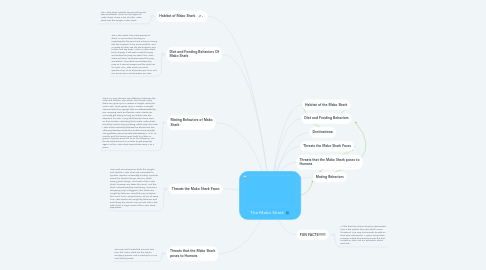The Mako Shark
von Zachary Davis

1. Habitat of Mako Shark
1.1. The Mako Shark inhabits temperate tropical seas worldwide. There are two types of Mako Shark. There is the Shortfin Mako Shark and the Longfin Mako Shark.
2. Diet and Feeding Behaviors Of Mako Shark
2.1. The Mako Shark, like most species of shark, is carnivorous, feeding on cephalopods like squid and octopus, boney fish like mackerel, tuna and swordfish, and a variety of other sea life like dolphins, sea turtles, and sea birds. When a Mako Shark finds its prey, it will swim under the prey and before the prey can react, the Mako Shark will swim vertically toward the prey and attack. This attack immobilizes the prey so it cannot escape and the shak has its meal. The Mako Shark can reach speeds of up to 32 kilometers per hour and can travel up to 55 kilometers per day.
3. Mating Behaviors of Mako Shark
3.1. There is a very obvious size difference between the male and female Mako Shark. The female Mako Shark can grow up to 3 meters in length, while the male Mako Shark grows up to 2 meters in length. These sharks form groups that are differentiated by sex, meaning male and female Mako Sharks can unusually get along as long as neither have the objective to mate. Many adult females have scars on their bodies, indicating that a male Mako Shark was likely violent during mating. Either way, the male Mako Shark internally fertilizes the female and the offspring develop inside the mother (ovoviviparity). The gestation period usually lasts between 15 to 18 months and the female gives birth to a litter, or group of young, around 4 to 25 live offspring. The female waits around 18 months to get pregnant again, so the Mako Shark reproduces every 2 to 3 years.
4. Threats the Mako Shark Faces
4.1. Like most animal species, both the Longfin and Shortfin Mako Shark are vulnerable to bycatch. Bycatch is basically hunting a specific animal for specific things, like fins, teeth, among other things. The teeth of the Mako Shark, however, are taken the most. And this shark is threatened by overfishing. It seems a whopping 30% of tagged Mako Sharks are caught by fisheries. Now that may not seem like much, but in simple terms, 30 out of every 100 Mako Sharks are caught by fisheries, and and taking the overall 72% survival rate in the wild, that s a huge chunk of the Mako Shark population.
5. Threats that the Mako Shark poses to Humans
5.1. The only real threats that humans face from the Mako Shark are the shark's terrifying speeds, and it's ability to JUMP onto fishing boats.
6. Threats that the Mako Shark poses to Humans
7. Threats the Mako Shark Faces
8. Diet and Feeding Behaviors
9. Habitat of the Mako Shark
10. Destinations:
11. Mating Behaviors
12. FUN FACTS!!!!!!!
12.1. All life that has a bone structure descended from a fish smaller than a(n) adult human thumbnail. The very first animals to walk on land were arthropods. A giant, ancient sea scorpion called Brontoscorpio was the first to walk on land, not our ancestors, which were fish.


